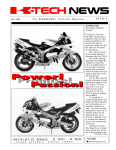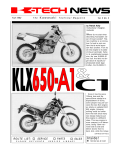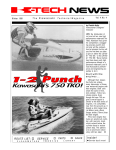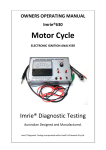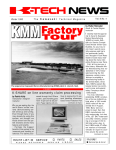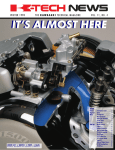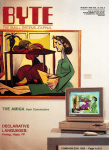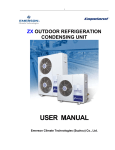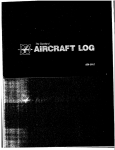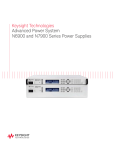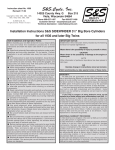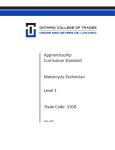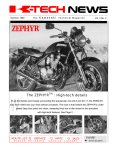Download K-Tech News Vol.6 No.2
Transcript
Summer 1993 The Kawasaki Technical Magazine Vol. 6 No. 2 by Patrick Kelly Instructional Designer/ Instructor Kawasaki ... Gear Up for the Good Times! That’s more than just a slogan— and for proof, just examine the specifications for the brand new 1994 KX125 and 250. One look at these virtually all-new machines will convince you that Kawasaki is indeed “Gearing Up for the Good Times!” The KX125-K1 The heart of every motocross machine is its engine, and the KX125-K1 has the cardiovascular development to match the best riders in the world. It has been thoroughly redesigned to increase its low- and mid-range power while maintaining its strong top end. To increase intake velocity and improve low-end torque, the reed valve has been reduced in size and the number of reed petals reduced from six to four. The reed valve material has also been changed from carbon fiber to epoxy resin for increased durability. The transfer and exhaust ports are changed in size and shape to boost low rpm torque. Transfer port timing remains unchanged while exhaust port timing is retarded slightly from 95° BBDC and ABDC to 94° BBDC and ABDC. CONTlNUED ON PAGE 2 ROUTE LIST: o SERVICE o PARTS P L E A S ER E T U R NT OS E R V I C EL I B R A R Y o SALES Inside! n Service tips & more! Gearing Up ... CONTINUED FROM PAGE 1 The crankcase is new too. It features a new intake port and new, lower transfer ports. A new expansion chamber and ignition timing data map work together to maximize the effect of all these changes. The power is fed through a new clutch and transmission. The clutch is 10mm larger in diameter for increased durability and features one less friction plate (seven, down from eight) for smoother engagement. The new transmission has been designed for increased dura- bility. The input and output shafts have been moved 2mm farther apart to allow for larger diameter gears and the diameter of the output shaft has also been increased 3mm. The transmission also benefits from stronger shift forks and a needle bearing added to the end of the shift drum, (ABOVE) Port comparison between the ’93 and ’94 KX250 and (BELOW) KX125 models. Dashed lines are the intake and exhaust tracts on the ’93 models; shaded areas represent the passageway shapes in the great new ’94 machinery. as well as revised gear ratios to match the new power characteristics. The KX250-K1 The KX250-K1 engine has also been revised to improve low- and midrange torque without sacriicing top end. The area of he carburetor holder and air guide in the reed block has been reduced in size 17 percent in order to increase intake velocity. The cylinder also features new porting designed to boost low speed power. The KX250-K1 also receives a new expansion chamber and ignition timing data map to maximize the benefit of the porting and intake tract changes. In the KX250-K1 transmission, the input shaft diameter is 3mm larger to handle the increased horsepower. Both machines benefit from refined cooling systems for ’94. Although they still retain a parallelflow cooling system, the radiator hoses are now a single rather than a dual design. The single radiator hose reduces flow resistance by 9 percent. Both engines also benefit from identical new radiators. The new radiators increase cooling capacity by 8.4 percent. New and improved The KX125-K1 and the KX250-K1 share a similar chassis. Both have been revised to improve cornering ability while maintaining excellent straight-line abilities. The frames are nearly identical and feature similar changes for ’94. The steering heads have been 2 l K-Tech News lowered and the frames’ dimensions changed to shorten their overall length. This contributes to shorter wheelbases for improved cornering. The rake angle on the 125 frame has been changed from 25.5° to 26° while the 250’s rake remains unchanged at 26°. Rigidity of both frames is improved with new gusseting and new steel rear sub frames. The KX125-K1 and KX250-K1 feature refined suspension systems as well. The front forks get a special coating to reduce initial harshness and the 125 gets new fork springs. The 125’s fork spring rate goes from .35 kg/mm to .38 kg/mm while the 250’s fork springs remain unchanged at .39 kg/mm. In the rear, both machines have stiffer spring rates. The 125 shock spring changes from 4.5 kg/mm to 4.7 kg/mm and the 250 shock spring changes from 4.7 kg/mm to 4.9 kg/mm. Both KX’s feature new Uni-Trak linkage ratios and larger compression damping valves to best match the new spring rates. The rear suspensions also boast a stronger, more rigid swingarm. The pivot area and cross piece are now hollow cast aluminum. This new cast piece IS joined to new lightweight single box section swingarm main tubes, replacing the dual box section main tubes used last year. The brakes on both machines have also been upgraded. The front master cylinder is changed to reduce the amount that the lever travels before the brakes are applied. The front caliper body has also been increased in rigidity. The overall result is improved braking and brake lever feel. The rear brake has been modified to give the rider improved control. Both the master cylinder bore and the caliper bore have been reduced in size and the brake hose has been changed to a higher expansion type. All of these front and rear brake changes also apply to the KX500 for ’94. There are many other polishing touches to the ’94 KX125 and 250 to round out the overall packages. The seat height is 10mm lower and the seat foam is now a dual-density type for improved wear and comfort. A new handlebar matches the new lower seat height and the KX250 handlebar now features weights to reduce vibration. Both bikes receive new Dunlop D737 rear tires. Dunlop K490s, identical externally but with new internal construction, are retained on the front of each bike. The 1994 KX125-K1 and KX250-K1 confirm Kawasaki’s commitment to being the best. The company is indeed “Geared Up for the Good Times”—good times in the winners circle! o (RIGHT) Another interesting comparison between ’93 (top) and ’94 (bottom) KX models: This is the new cooling system layout. The Technical Magazine 3 l Summer 1993 Vol. 6 No. 2 ©1993 Kawasaki Motors Corp., U.S.A. (KMC). All rights reserved. Service materials mailings for ’93 models K-Tech News Staff Microby David Pyle Parts Publications Specialist by Ray St. John Publisher Kawasaki Tech Services Publications Manager Don Church Executive Editor Gary Herzog Editor-in-Chief Gregg Thompson Communications Editor Patrick Kelly Regional Editors North and East Fred DeHart Central and South Walter Rainwater Contributors Dave Behlings, Keith Pestotnik, John Porno, David Pyle, Mary Sola, Ray St. John Graphics/Production Graphic Art Gregg Thompson Copy Editor Pat Shibata Production Nickless Communications Published by Kawasaki. All suggestions become the property of KMC. Sending a service suggestion gives Kawasaki permission to publish and/or use it without further consideration. Specifications subject to change without notice. 4 l K-Tech News Supervisor, Technical Writing We get a lot of calls from dealers asking about service manuals and assembly and preparation manuals on the ’93 models. Most of the time we tell them, “Yup. We mailed that out last month, and you’re on the list.” But, just to fill everyone in, here’s what we’ve sent out so far on the ’93 models: Service Manuals Manual for: Sent: KLF400-B1 ZR1100-A2 ZX750-L1/M1 (Supp.) ZX1100-D1 ZX600-E1 (supp.) KLX650-A1/C1 March 27, 1992 July 31, 1992 December 11, 1992 March 18, 1993 March 19, 1993 April 9, 1993 Assembly and Preparation Manuals Manual for: Sent: KLF400-B1 ZR1100-A2 ZX750-L1/M1 ZX1100-D1 KLX650-C1 ZX600-E1 KAF620-A1/B1 KLX650-A1 EX250-F7 JH750-B1 KAF300-B1 May 5, 1992 July 31, 1992 October 23, 1992 January 22, 1993 January 22, 1993 January 22, 1993 February 5, 1993 February 12, 1993 March 26, 1993 April 16, 1993 May 6, 1993 Miscellaneous Sent: Item: “How We Stack Up 1993” February 26, 1993 We mail out publications as soon as we get them, so you may have gotten something after the last item on our list here. The lead time between my writing this column and you receiving K-Tech News is about 60 days. If you need to order any of these publications, look on Grid A-2 of the parts catalog microfiche for the part numbers. There’s lots of interesting reading and important information in these manuals for you and your service personnel. o Did you know that there is more information on your parts microfiche than just part numbers? We include extra information to make each microfiche a multipurpose reference source. Below is some of the useful information found on each specific models microfiche. Assy. & Prep sheet An “Assembly and Prep Sheet” is located on the “M” row of each specific model microfiche. Here is a copy of this important document that is less likely to get lost or damaged. Use this as a backup to the paper copy filed in your A & P binder. The A & P sheet is included on the first edition of the microfiche for a new model if it is available; if not, then it is included on the first revision. Bulletins All bulletins pertaining to a particular model are included on the IN” row on the first revision following the issue of the bulletin. And don’t forget about the Service Bulletin microfiche: P/N 99961-0365 covers ’90-’92 Motorcycle Service Bulletins and P/N 99961-0366 covers ’90’92 Watercraft Service Bulletins. Part number list Located at the end of the “O” row is a list with every part number found on that microfiche. This can be used to quickly locate a known part number CONTlNUED ON PAGE 5 KLX650-C1 ignition tests by Fred DeHart Technical Services Instructor Here at the “Big K”, we prefer to use voltage tests when checking electrical components whenever possible. The resistance values given in the service manuals just don’t seem to find the problem all that often. Recently I conducted some tests on the ignition components of a running KLX650-C1 with both a voltmeter and the Kawasaki CD Ignition Tester, just to get some numbers to go by. If you are troubIeshooting a KLX ignition, you can use these values but bear in mind that these numbers are from only one unit. The numbers from the motorcycle you are working on could be slightly different and still be OK. Do these tests with the spark plug removed: Test I: Pick-up coil output 1. With the 2-pin connector from the pick-up coil disconnected, connect either the voltmeter or Kawasaki Ignition Tester to the wires coming from the p/u coil. 2. Set the voltmeter to a low AC voltage scale or Ignition Tester to Low 35. Micro-K CONTINUED FROM PAGE 4 on the microfiche. It can also be used to find out if a pat-l is used more than once on a unit. For example: KX125-J2 microfiche grid 0-13 shows that P/N 92015-1078 is used on four different grids. 3. Crank the engine over using the starter motor. 4. Voltage output should be about 1/2 VAC. Test II: Exciter coil output 1. With the 2-pin connector from the exciter coil disconnected, connect your voltmeter or Ignition Tester to the wires coming from the exciter coil. 2. Set the voltmeter to a high AC scale or Ignition Tester to High 40. 3. Crank the engine over using the starter motor. 4. Voltage output should be about 50 VAC. Test Ill: Igniter output (CD Ignition Tester only) 1. With the black/white wire disconnected from the coil, connect the Ignition Tester and the load coil. Connect the Tester’s yellow lead and one lead from the load coil to the b/w wire. Connect the Tester’s red lead and the other load coil lead to a good engine ground. 2. Set the Tester to Low 95 or High 10. The tester light should go on with either setting while cranking the engine over using the starter motor. o This can be handy when deciding how many of a part to stock. Don’t forget that specs, model I.D. photo, and beginning and ending frame numbers can also be found on the microfiche. The parts microfiche is a powerful tool; start taking advantage of it today! o The Technical Magazine 5 l Service Contest #2: Still more winning results are in! We had a great response to our K-Tech News Service Contest #2, which appeared as an insert in our last issue (Vol. 6 No. 1). In the “diploma” on page 6 are the names of the technicians who scored 85 per- cent or better. Once again, all will be receiving an award-and if your name is there, congratulations! If your name does not appear, please don’t give up; keep trying. You still have one more chance to R eady for the final K-Tech News Service Contest #3? Well here it is! Whether you took the first two tests or are a newcomer to the competition, it’s time to sharpen your pencils and get right to it. A complete list of contest rules has appeared in each of the last two issues; please refer back to them if you have any questions. “Rules Highlights” appear below: win. Our final Service Contest #3 is included in this issue. As we’ve explained, each test is graded separately, so even if you didn’t enter Contest #1 or #2, you can still win awards by entering this one. l In order to compete for the grand award, all three tests must have been completed and returned by their respective deadlines. l Send completed tests to: Service Contest, Kawasaki Motors Corp., U.S.A., 9950 Jeronimo Road, Irvine, CA 92718. Good luck! Highlights of the Contest Rules l Contest #3 answer sheets must be mailed to the address printed below on or before Aug 13th. l The Service Contest is open to any full-line dealership Service Department personnel. l The contestant may use any materials and information available to answer the test questions. l Any contestant who scores higher than 85 percent will receive an award for that test. l Copies or facsimiles of the answer sheet are OK. The deadline for mailing in Contest #3 (inserted into the center of this issue) is Aug. 13. (Don’t let Friday the 13th bother you!) Good luck and thanks for participating! - Ed. The award for Service Contest #2 is Snap-on Tool’s neat palm-style ratchet with 3" wobbledrive extension. DATA Bayou 400 neutral switch improvements S ome KLF400B model ATVs may develop a problem with the neutral indicator switch making it difficult to start the engine. Typically, one must push down or pull up slightly on the shift pedal to get the neutral lamp to illuminate, allowing the starter circuit to operate. To correct this condition, some improved parts are now available as found in later production units. You’ll need one each of the following parts to make repairs: P/N 13151-1077 Switch, neutral P/N 13244-1055 Stopper, reverse P/N 11060-1204 Gasket, bevel gearcase P/N 11060-1209 Gasket, clutch cover P/N 92015-1880 Nut, front clutch Follow the service manual for general repair information, but to save labor time, do not remove the engine from the frame. Instead, remove the shift shaft from the right-hand side providing clearance to get the bevel gearcase off the left-hand side, as detailed in the Winter ’92 issue of K-Tech News (Vol. 5, No. 4, pg. 7). - Keith Pestotnik Vulcan voltage T he Vulcan 700/750 service manual doesn’t give you the open-circuit AC voltage of the alternator. So we will: Measure the voltage with the stator wires unplugged from the system and the engine running at 3000 rpm. The voltage between any two of the three yellow wires coming from the stator should be about 50 VAC. The voltage will continue to rise if the engine is rewed above 3000 rpm. If the voltage is checked at these same connectors with the stator in-circuit (wires plugged in), it will be about 14 VAC or so. - Fred DeHart The Technical Magazine 7 l Choosing the right glue for those rubber parts by Gregg Thompson Product Support Supervisor There has been some confusion lately regarding what kinds of glue to use installing the various mats and pads on our watercraft. There’s even some incorrect information in our service manuals. So here’s some general information that should get you through installing just about any of these rubber parts with minimum hassle. At this time, there are three basic types of glued-on rubber parts found on our watercraft.: thick soft foam rubber (mats); thin hard rubber; and engine hood gaskets. The thick, soft, foam rubber floor mats used on our stand-up models should be installed using a good quality waterproof contact cement. The cement should be painted on the backside of the mat and on the hull (cover the whole surface) and should be allowed to dry before installing the mat. This type of glue will not adhere properly if the mat is installed before the glue is dry. You can get this type of glue (and a cheap throw-away paint brush with which to apply it) from a lo8 K-Tech News l cal paint or hardware store. The thinner, hard-rubber mats that are used in the footwells of our sit-down models cannot be installed with the contact cement. It won’t adhere to this type of rubber. For the mats as well as handlebar install some of these larger floor mats. The little tubes or bottles you find at the local market just aren’t big enough. For that reason, we are working to make an easyto-use cyanoacrylate glue available from our Acces- grips, and those rubber blocks (“detents”) used to keep cables and hoses neatly routed in the hull, you should use a cyanoacrylate glue (super glue). There are several different types of cyanoacrylate glue, and they should all work well for these mats, but you may run into a little difficulty finding it in large enough quantities to sories Department in larger bottles. We’ll get the part number to you as soon as we have it. This glue is thicker and slower to set up than most super glues so it’s a little easier to work with when installing a large mat. The weather strippinglike gaskets used on our engine hoods and storage compartment lids can be installed with either of the two glues already mentioned, but we also sell a glue that’s ideal for this kind of job. This is a very high quality contact cement (you know, apply to both surfaces, let it dry ...) and it comes in a toothpaste-size tube that makes it easy to use for small jobs. Order it by P/N 921043701. There is one glued-on pad that is different from all the others and it requires another method of installation. The side rail pads on the JF650-B “Tandem Sport” are glued on at the factory using the same green adhesive used to bond the top and bottom halves of the hull together. This glue is not available but you can use Kawasaki’s Hull Repair Kit instead. Rough up the hull surface and the plastic base of the pad with very coarse sand paper, and drill a couple of 1/4” holes in the pad base. Then, mix up a batch of Hull Repair Kit, apply it to the hull, and press the pad in place firmly. Just make sure you let this set up overnight before giving it the old 40mph submarine test. o Knocking noises in ZX600-D series engines by Keith Pestotnik Rocky Mountain Kawasaki Have you ever done a valve adjustment on a “D” Model ZX-6 only to have a loud tapping noise in the valve train appear after the adjustment? Believe it or not, this is a fairly common occurrence. This model is very sensitive to cam bearing clearance and this clearance can be affected by how you tighten down the cam bearing caps. NOTE: With this model engine, a cam bearing clearance noise will usually be loudest when the engine is cold and decrease as it warms up. When installing the cams in a ZX600-D engine, a good rule-of-thumb is to push forward (toward the front of the engine) firmly on the bearing caps as you begin to tighten them against the head. This is important to maintaining minimum bearing clearance on these engines. Also, use hand tools only (no air wrenches!), follow the tightening procedure exactly as described in the service manual. Use a good torque wrench. Following these procedures will reduce the chances of creating a noise that wasn’t there before you adjusted the valves. If the customer comes in complaining of a noise, check all the usual things and then re-torque the cam bearing caps using this procedure. If the noise persists, call the KMC Product Support Hot Line or call me at Rocky Mountain Kawasaki. o FRONT Float chamber ram air: a tip for your active memory! H ere’s one that you should store in the “easy access” portion of your memory banks. Knowing this fact could save you a lot of time some day: The ram air intake systems on our latest “ZX” street bikes are designed to deliver pressurized air to the carburetors. The faster the bike goes, the greater the boost. Although the pressure in the air box never rises to the levels seen in superchargers and turbochargers, it does go above atmospheric pressure. Since more conventional intake systems run at pressures well below atmospheric, these new ram air systems are significantly better. However, for the carburetor to deliver any fuel to the engine, the pressure on the fuel in the float bowl must be greater than the pressure in the venturi. As the pressure in the air box rises, the pressure in the float chambers must also rise or the fuel will simply stop flowing through the jets. To keep float-chamber pressures up, Kawasaki has routed the carburetor vent tubes forward to the mouth of the air inlet scoops. The shape and placement of these vent tube openings are critical to their proper function. There are several connectors in these tubes between the inlet at the front of the fairing and the float chambers. California models also have a valve in the vent line that routes the vent to the charcoal canister when the engine is off. If one of these tubes becomes disconnected anywhere in the system, the pressure in the float chamber goes down and fuel flow through the jets is reduced or even stopped. The result of a disconnected carburetor vent tube is a very bad throttle hesitation at moderate speeds that only gets worse as the speed increases. In the case of the ZX600-E, the engine just signs off at 4000-5000 rpm in low gears. If you ever find yourself trying to diagnose a throttle hesitation on one of these ram air units, don’t forget to check out the carburetor vent system very carefully. - Gregg Thompson The Technical Magazine 9 l The engine is using too much oil? Now what? by John Pomo Product Support Specialist Sooner or later (maybe today, eh?) a customer will come into your shop complaining that his motorcycle is using too much oil. If he expects to have this covered by warranty, there are a few things you should do to verify the problem before calling the Hot Line. Depending on the type of vehicle and other factors, oil consumption as high as one quart per 500 miles may be considered normal. Before calling us, determine exactly how much oil the engine is using. Have the customer bring the bike to your shop so you can put it up on its center stand (if it has one) on your shop floor and top off the oil. If it has no center stand, hold the bike in a position that can be precisely duplicated later. Record the mileage and send TIP Despite the rumors, dirt is not a defect! Quite often, we on the Hot Line will receive, from a dealer, engine top end parts that were replaced under warranty because of abnormal wear. Generally, the dealer has no idea what caused it. Well, nearly always this “abnormal wear” was caused by dirt that entered theengine through the intake system. The problem is that unless there was a defect in the intake system that let the dirt in, this kind of failure is not really covered by warranty. Most likely, the dirt got into the engine due to improper maintenance (or lack of it), or some modification to the air cleaner system. With our four-stroke en10 l K-Tech News gines, the damage from dirt is pretty easy to spot. The piston and rings receive the most wear. The piston will have a dull grey appearance, as though it had been wetsanded with very fine sand paper (the sanding strokes all in avertical direction). The circumferential machining marks you would normally see on a piston skirt are gone. The rings, meanwhile, will be very polished on the edges and sharp as a razor. Other pans that will be noticeably worn are the wrist pin, cylinder, and cam chain. Parts that are pressure lubed don’t suffer as much wear because the oil filter does a good job of removing most of the dirt-that is, if the filter getschanged often enough. Any time you spot abnormal wear in an engine’s top end, inspect the parts with all this in mind. If you were thinking of submitting a warranty claim for the repair but see the tell-tale signs of dirt, you should reconsider whether or not this really is a warranty situation. -Dave Behlings the customer on his way, with instructions to bring the bike back to you when be believes it needs to have oil added. When he brings it back, add oil carefully and keep track of exactly how much oil it takes. Note the exact number of miles he has put on since the last check. (It’s probably best to do this a couple of times— adding up the oil used and the mileage ridden—in order to get a more accurate consumption rate.) Make sure the engine is fully warmed up each time you check or add oil. Sometimes your test may cover only a few hundred miles and a small fraction of a quart of oil, so you need to be consistent and precise. For mileage readings, use the odometer, not the trip meter. For someone who wants his engine rebuilt under warranty, it’s pretty tempting to know that all he has to do is ride 100 miles, sort of accidently bump the trip reset knob, ride it another 100 miles and bring it to you with his measured oil consumption exactly doubled ... Once you are confident that you have an accurate oil consumption figure, call the Hot Line and we can discuss what to do and what not to do. o Old news is good news! As we launch head-on into another JET SKI® season, we thought we’d reprint this old K-Tech News article that hasn’t lost its appeal. -Ed. What’s wrong with this picture? by Gregg Thompson Product Support Supervisor How to be a hero by Mary Sola Assistant Manager, Consumer Affairs If you find yourself faced with a cracked Kawasaki water- W hat’s something you craft hull that needs to be repaired under warranty, the first thing you should do is call the Hot Line. The Hot Line technician will probably ask you to take some pictures of the damage and send them along with a written estimate for inspection. But taking good pictures of a crack in a nice white hull can be a little tricky ... A large percentage of the photos we receive don’t serve any purpose because they don’t clearly show the damage. Most often the photos are either out of focus or over-exposed. Here are some suggestions for taking better pictures that will allow us to see the damage: l Take the pictures in a well-lighted area, preferably outdoors but not in direct sunlight—direct sunlight is too bright and the white hull will be overexposed, washing out the crack completely. It’s best to take the picture on a sunny day in the shade of a building. l Don’t use a flash. Just like the sun, a camera flash reflecting off the glossy white hull will overexpose the area you’re trying to show. l Increase the visibility of the crack. Rub some charcoal or graphite (pencil lead) into the crack. Then wipe it off with a clean cloth. The charcoal will wipe right off the paint, but stay in the fibers of the cracked area. l Make sure your pictures are in focus. If you’re using a Polaroid camera, don’t get too close! Most Polaroid cameras won’t focus any closer than about three feet or so. The same holds true for many “point and shoot” autofocus 35mm cameras. Check on the lens bezel or in the owner’s manual to find the minimum distance for your camera. l Remember, if you take a picture that doesn’t clearly show the damage, don’t send it. Take another one. We can’t make a decision about warranty authorization if we can’t see the problem. o can give your customers at little or no cost which promotes good will and makes you look like a hero? Technical information and assistance! Here in Consumer Services, we get many calls asking for technical advice or information. Unfortunately, Consumer Services is not set up to be a technically oriented department, and we cannot connect customers to those departments at KMC (like the Hot Line) which do have technical expertise. What do we do? In most cases, we refer customers back to their dealers for help. Surprisingly, the majority of customers who call us are looking for rather simple information, such as the correct fork oil, valve timing data, gear ratios, carburetor settings, year and model of a unit, maintenance schedules, etc. All of this information can be easily found by checking the appropriate microfiche, owner’s or service manual, service specification handbook, or model recognition manual. When you have a customer who needs this type of information, you look good when you are able to provide it without having to refer the customer elsewhere. It is also an opportunity, in many cases, to sell service or parts, even if it’s only an owner’s manual. In cases where more complex questions are involved, then Consumer Services will always refer the customer to an authorized dealer and suggest that the dealer call the Hot Line if unable to resolve the problem alone. If you have a customer with a problem, question, or situation that you don’t know the answer to, why not take the time to call on your toll-free number to our technical staff. This will not only save your customers money, but time and ultimately frustration, too, since we won’t have to refer them right back to you for help! Remember what we always tell the customer: Our dealers are our technical representatives in the field. o Get it while it’s hot! This issue marks your final opportunity to participate in the ’92 K-Tech News Service Contest. Hard, yeah, but the prizes have made it all worthwhile, right? Contest #3 questions and answer sheet are in the middle of this newsletter. Go for it! -Ed. The Technical Magazine l 11 R E G I O N A L N E W S Training Schedule East Region North Region Central Region South Region West Region KMC instructors are working now on the 1993 Training Program schedule. Classes will begin again in October. All dealers will receive a copy of the winter class schedule, but don’t forget to watch this space in the Fall and Winter issues of K-Tech News. WEST What will be new? by Patrick Kelly 9950 Jeronimo Road Irvine, CA 92718 (714) 770-0400 T he 1993 training season s over, the final classes having been presented at the end of May. Now it’s time for the whole instructional staff to sit down and analyze the degree of success that was achieved in training this spring, and look for ways to improve upon that in the coming year. We are always searching for better ways to provide dealers with technical information and knowledge. By the time you read this we will have already had our national training meeting and formulated some new ideas and directions to take. Last year’s meeting brought the Service Contest, as well as the Tune and Service class and the Precision Measurement class. What new ideas did we hatch up for you at this 12 K-Tech News l year’s meeting? Well, as I write this, I don’t know yet, but you can rest assured that there will be something new in store. To find out what it is, keep your eyes peeled for the fall training schedule and the fall issue of KTech News! o SOUTH & CENTRAL The busy summer by Walter Rainwater 6110 Boat Rock Blvd. S.W. Atlanta, GA 30378 (404) 349-2000 A ttendance at our training classes was very good this season. I always enjoy teaching and sharing information about Kawasaki products. The 1993-’94 training season starts in October: Watch for the training schedule and please do sign up for the classes of your choice. Part of my summer includes working on the Hot Line and I will be ‘on line’ during June and August. I look forward to talking with you during that time. Be sure to call if you have any questions I can help you with! I’m also looking forward to helping out at various Kawasaki demo rides this summer; it’s great summer fun. I’ll get a chance to work with the local dealers and to meet new Kawasaki customers. Maybe I will see some of you there! If you need help any other time, you can reach me at the South Region office. I hope you have as great a summer as I will! o NORTH & EAST Have a good summer! by Fred DeHart 201 Circle Drive N., #107 Piscataway, NJ 08854 (201) 469-1221 This issue of K-Tech News contains the third and final test in our Service Contest series. To all the dealership mechanics who are participating: good luck! Thanks for entering the contest and I hope that everyone learned some new information from the questions. Our ’93 training season came to a close at the end of May, but ’94 classes will begin in the fall. Be sure to watch for a new training schedule which should arrive at your dealership sometime in October. In the meantime, I can be reached at our regional office if you have any questions. I will also be working on the Hot Line during the months of July and August. Have a good summer season and I look forward to talking with you as it goes along! o












